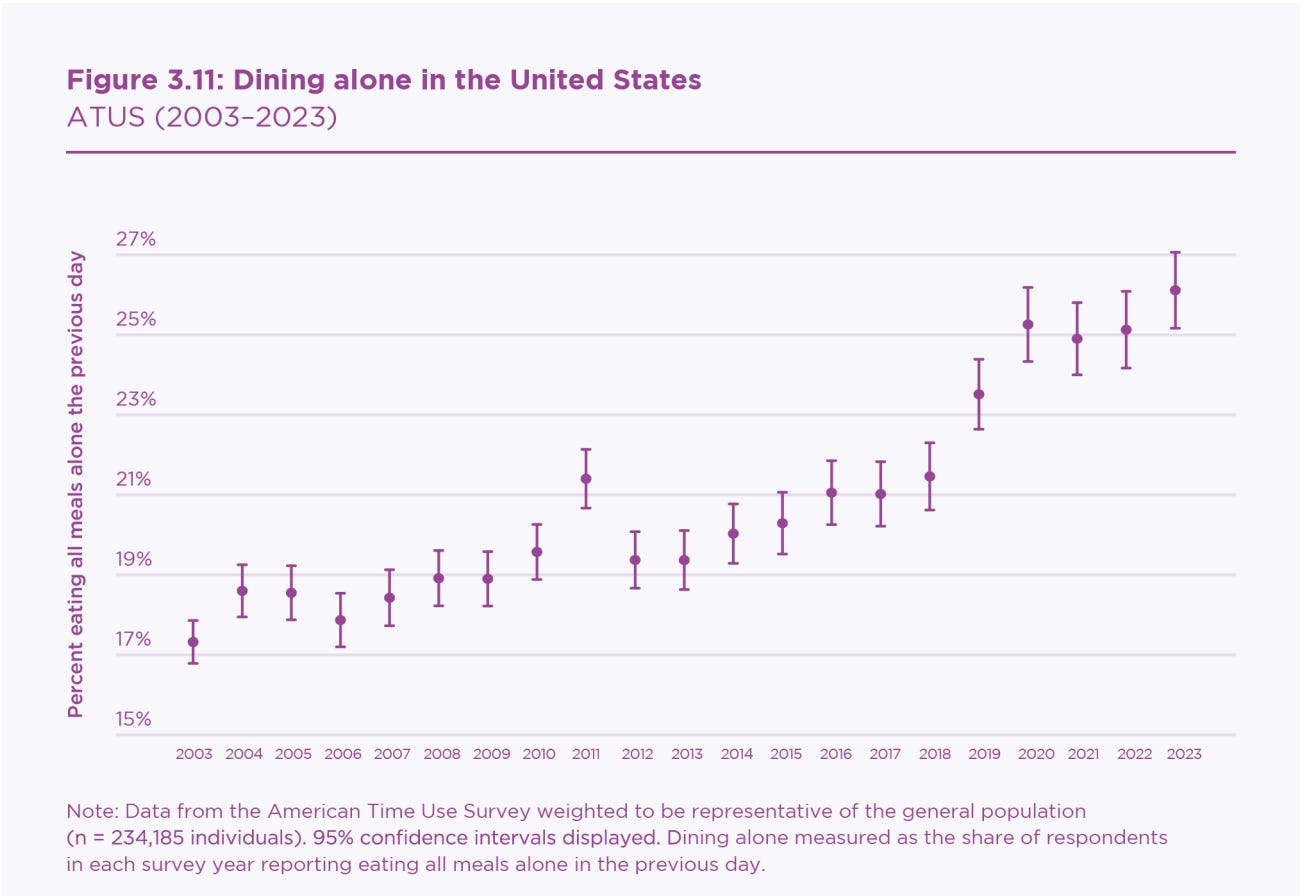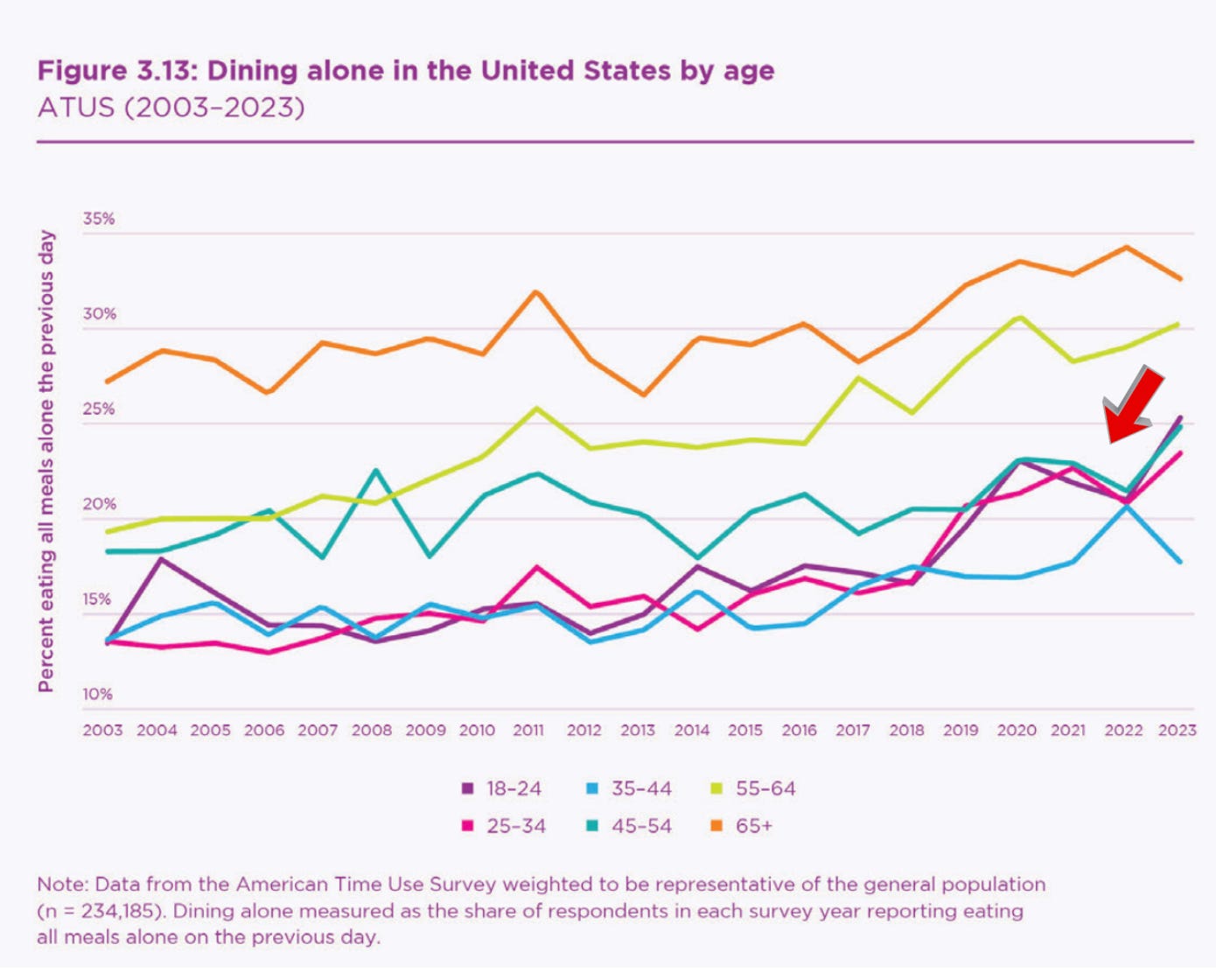TL;DR
Sharing meals is as powerful a predictor of happiness as having a job.
People who shared just one meal with others in the past week were measurably happier than total solo diners.
Americans eating alone has increased 53% since 2003, with a quarter of Americans now dining alone.
Young adults (25-34) are nearly three times more likely to eat alone than they were in 2003.
Restaurants function as social infrastructure as critical as parks or libraries.
The rise in delivery and takeout may be undermining restaurants' social function when it's most needed.
Restaurants have opportunities to partner with healthcare, technology companies, urban planners, and local governments to encourage shared dining experiences.
Audio by Eleven Labs can be a little wonky
The World Happiness Report 2025 just came out- spoiler alert- Finland won for the 8th straight year. But I want to talk about Chapter 3 specifically. For the first time, researchers have quantified what many restaurant professionals intuitively understood: sharing meals with others is profoundly linked to our wellbeing and, as noted here, here, here and basically everywhere else in this newsletter, restaurants are increasingly where we eat.
The report analyzes data from over 150,000 people across 142 countries, examining how often they share meals with others and how this correlates with happiness. The findings are clear: individuals who share more meals with others report significantly higher levels of life satisfaction, more positive emotions, and fewer negative emotions. This relationship holds true across regions, genders, ages, and income levels. The report does stop short of asserting causation but the correlation is too stark to ignore.
Perhaps most striking is how powerful meal sharing appears to be as a predictor of wellbeing. Want to guess if someone's happy with their life? Knowing whether they shared a meal last week tells you more than knowing if they have a job. When it comes to feeling positive emotions day-to-day, sharing meals with others matters more than how much money you make and whether you're employed - combined. The correlation between positive affect and meal sharing is 0.44, stronger than the correlation with life evaluations (0.34) or negative affect (-0.21).
In practical terms, sharing just one more meal per week with someone is linked to enough happiness to bump a country up 5 spots in the global happiness rankings - approximately 0.2 points on a 0-10 life satisfaction scale. People who ate even one meal with others in the past week were significantly happier than those who ate alone - scoring 5.2 versus 4.9 on life evaluations, a difference that's about half as large as what you'd lose from becoming unemployed.
At the same time, the data shows concerning trends. In the United States, the percentage of people eating all their meals alone has increased by 53% since 2003. One in four Americans now eats all their meals alone - that's 50% more lone diners than we had 20 years ago. This trend is particularly pronounced among young adults. Young adults (25-34) are nearly three times more likely to eat all meals alone than they were in 2003, with rates increasing by more than 180% in two decades.
These findings ought to reposition restaurants in society's priorities. They aren't just businesses selling food and drinks - they're venues that facilitate one of the strongest predictors of happiness we have. When people dine together at restaurants, they're not just consuming calories; they're engaging in an activity that promotes wellbeing at both individual and societal levels.
The report even suggests that meal sharing might be a more reliable indicator of social connection than many subjective measures. Unlike self-reported assessments of loneliness or closeness to others, sharing meals is relatively objective and comparable across cultures and over time. It's a universal practice that translates across borders and languages.
Regional differences in meal sharing are substantial. Latin America and the Caribbean lead the world in meal sharing, with residents sharing approximately 9 meals per week with others. By contrast, people in South Asia report sharing fewer than 4 meals per week. At the country level, Senegal tops the list with residents sharing 11.7 meals weekly, while Bangladesh and Estonia report just 2.7 shared meals per week.
These variations aren't fully explained by differences in income, employment, or household size. Even when researchers controlled for all the obvious factors that might explain the connection (income, age, education, employment, household size, food security), meal sharing still strongly predicted happiness. Cultural and social factors clearly play important roles in determining how often people dine together. This suggests that restaurant operators and policymakers have significant room to influence meal sharing practices.
Young people in the United States are experiencing the most dramatic declines in meal sharing. This is particularly worrying given that the report finds meal sharing to be especially important for the wellbeing of younger adults. When comparing young people who dine alone to those who share meals, researchers found much greater differences in happiness than among older adults.
The timing of these declines is noteworthy. While many might assume that smartphones and social media are to blame, the data shows that the steepest increases in dining alone occurred after 2015, not immediately following the introduction of smartphones or major social platforms. Similarly, while the pandemic certainly contributed to increased isolation, the trends toward dining alone were well established before COVID-19 arrived.
These findings pose a critical challenge to restaurants targeting younger demographics. How can establishments create environments and experiences that encourage meal sharing among a generation increasingly accustomed to dining alone? The happiness benefits for these guests could be substantial, potentially creating stronger loyalty and more positive associations with establishments that successfully foster social dining.
Restaurants facilitate exactly the kind of meal sharing that the World Happiness Report identifies as crucial for wellbeing. This positions them not just as businesses but as social infrastructure – similar to parks, libraries, and community centers that provide essential public benefits.
The researchers found that people who share more meals with others are significantly less likely to feel lonely and significantly more likely to experience social support. Countries where people share more meals have higher levels of positive reciprocity and social support. Meanwhile, dining alone is associated with higher levels of negative emotions, particularly for women.
In North America specifically, sharing meals has a stronger connection to happiness than almost anywhere else in the world - suggesting that in our increasingly isolated society, breaking bread together might be especially meaningful. The data shows that Americans who share at least one meal with others rate their overall life satisfaction half a point higher on a 10-point scale than those who always eat alone - a substantial difference in happiness research.
This raises important questions about how we value restaurants as a society. If sharing meals in restaurants provides such substantial social benefits, should we be reconsidering how we support and regulate them? The economic pressures pushing restaurants toward delivery and takeout models may be undermining their social function precisely when it's most needed.
The findings in the World Happiness Report suggest opportunities for restaurants to form strategic partnerships that both enhance their social impact and address economic challenges. Restaurants overlap public health, community development, and economic activity - making them ideal collaborators for cross-sector initiatives.
Healthcare systems increasingly recognize social determinants of health, including loneliness and isolation, as key factors in physical wellbeing. Forward-thinking healthcare providers might see value in partnering with restaurants to create "social prescription" programs where medical professionals can refer patients experiencing isolation to communal dining experiences. Some health insurers are already experimenting with food-as-medicine programs; extending this to include the social aspects of dining would be a natural evolution.
Technology companies could develop tools specifically designed to facilitate shared meals rather than solitary ones. While delivery apps have optimized for individual convenience, new platforms could focus on connecting solo diners, coordinating group reservations, or gamifying the shared meal experience. Restaurants that provide the physical space for these connections would benefit from increased covers and potentially higher check averages when people dine together.
Urban planners and property developers represent another natural partnership opportunity. As I've discussed in previous newsletters, restaurants increasingly drive ground floor commercial real estate. The World Happiness Report's findings provide compelling evidence that developments incorporating spaces specifically designed for communal dining deliver measurable wellbeing benefits to residents and communities - potentially increasing property values and tenant satisfaction.
Local governments might also reconsider their relationship with restaurants in light of this data. Rather than viewing them primarily as tax revenue generators requiring regulation, municipalities could treat restaurants as partners in building community resilience and public health. This might translate to streamlined permitting processes for establishments that incorporate design elements encouraging shared dining, tax incentives for restaurants that host community meals, or direct subsidies for programs targeting isolated populations.

The World Happiness Report validates what many restaurant professionals have intuitively known: sharing meals matters profoundly for human wellbeing, and restaurants are central to this practice. As an industry, we have the opportunity to embrace this role more explicitly, positioning restaurants not just as businesses but as essential contributors to individual and community happiness.
The findings should also prompt a reconsideration of how society and governments measure measure the impact of the restaurant industry. Beyond rent, taxes and other economic indicators covers perhaps we should be asking: How many shared meals did we facilitate? How much connection did we foster? How much happiness did we generate? These may seem like pretty squishy metrics, but the World Happiness Report suggests they might actually be among the most important measures of all.










Wouldn't it be an incredible thing if full service restaurants were given a tax break or additional funding because of the business' potential to make happiness contributions to the city/town population's mental wellbeing!
Great piece Eli!